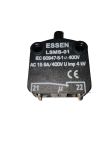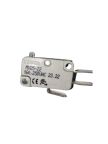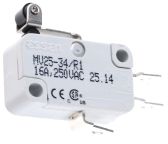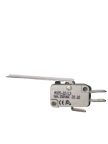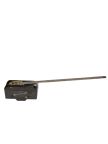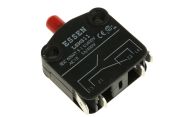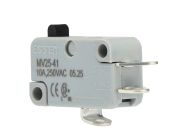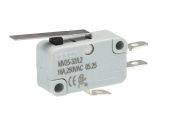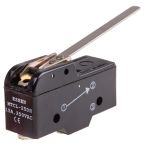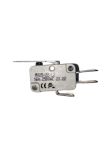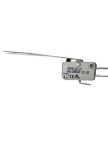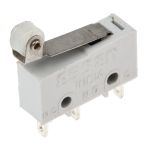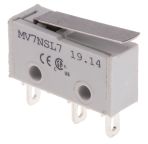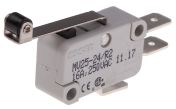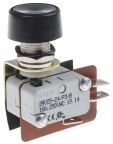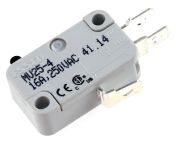Micro Switches
Micro switches are mechanically operated electronic switches designed with an actuator and terminals called common, normally open, and normally closed. Also referred to as snap-action switches, micro switches operate using a spring-loaded lever that opens and closes a set of internal contacts within the unit.
How Does a Micro Switch Work?
Power is typically attached to the common terminal, energising the spring within the switch. In its resting state, the spring touches the normally closed pin, allowing power to flow through this pathway. When the actuator arm is moved, by pressing a button or applying force, the power is redirected to the normally open pin. This mechanism allows for precise control of electrical circuits, making micro switches ideal for applications requiring reliable on/off functionality.
Where Would You Find Them?
Micro switches are differentiated by their electrical characteristics. These are small devices and generally only designed to carry low currents and voltages. These switches are very commonly employed as safety devices, as they are reliable, inexpensive, and can open up a circuit when needed, similar to limit switches, preventing a machine from being turned on or a door from closing when someone is in the way.
Actuator Types
There are various types available, but the operating principles are the same, micro switches are actuated by a plunger, a button, a roller, or a lever.
- Plunger Actuators: Activated by pressing down on a plunger.
- Button Actuators: Operated by pushing a button.
- Roller Actuators: Utilise a roller that moves along a surface to activate the switch.
- Lever Actuators: Engage when a lever is pushed or pulled.
What Is Their Operating Life?
Micro switches typically have a long operating life, often measured in millions of cycles. While consumer-grade micro switches may have lighter-duty specifications, industrial-grade models are built for durability and can last over 10 million cycles. The low cost of these components makes it feasible to upgrade to higher-rated switches when necessary, ensuring longevity and reliability in demanding applications.
What Type of Applications Need Micro Switches?
Micro switches are widely utilised across both consumer devices and industrial equipment. They are commonly found in door interlocks to ensure that doors are closed before operation, in microwave ovens to prevent use when the door is open, and in vending machines to activate mechanisms upon button presses or coin insertions. Additionally, they serve as safety switches in lifts and help monitor dampers and control fan operations in HVAC systems.
These switches can also be designed for high sensitivity, making them ideal for precise applications like measuring air or gas flow rates. Their reliability and versatility enable them to play a crucial role in control circuits across various industries, significantly enhancing operational safety and efficiency.
How to Choose the Right Micro Switch That Fits My Needs?
To select the right micro switch available from various manufacturers, you can consider the key factors listed below:
- Actuation Type: Micro switches come in different actuation types, including mechanical, plunger, roller, and toggle. Choose an actuation type based on your application’s requirements, such as how the button will be activated.
- Mounting Style: The mounting style of the micro switch is crucial for installation. Options include panel mount, PCB mount, and surface mount. Ensure the chosen style fits your design constraints and provides the necessary stability for your application.
- Electrical Rating: Check the electrical rating of the miniature switch to ensure it can handle the required voltage and current levels. This limit should match or exceed the specifications of the circuit in which it will be used, preventing overheating or failure.
- Operating Force: The operating force is the amount of pressure required to activate the switch. Depending on your application, you may need a light touch or a more substantial force. Evaluate the desired sensitivity and ensure the switch meets these requirements.
- Size and Form Factor: Consider the size and form factor of the micro switch, especially if space is limited. Different designs are available to fit various applications, so select one that meets your dimensional constraints while maintaining functionality.
- Contact Configuration: Micro switches can have different contact configurations. Choose a configuration that suits your circuit design and ensures proper functionality in your application.
- Environmental Rating: If the micro switch will be exposed to harsh conditions, consider its environmental rating. Look for buttons with ingress protection (IP) ratings that indicate resistance to dust, moisture, and chemicals, ensuring longevity in challenging environments.
- Temperature Range: The temperature range is critical for ensuring reliable operation in different conditions. Check the specifications to ensure the micro switch can function effectively within the expected temperature range of your application.
Industrial Applications of Micro Switches
Here are some key sectors where micro switches are widely used:
- Automotive Systems: In automotive applications, micro switches are used for safety features, such as seatbelt reminders, door open/close sensors, and brake light activation. Their reliability is crucial for maintaining vehicle safety and functionality.
- Industrial Machinery: Micro switches are integral to industrial machinery, providing precise control in automated systems. They are used for limit sensing, position detection, and safety interlocks, ensuring efficient and safe machine operation in manufacturing processes.
- Medical Devices: In the medical field, miniature switches are used in devices such as patient monitoring systems, infusion pumps, and diagnostic equipment. Their reliability and accuracy are vital for patient safety and effective medical outcomes.
- HVAC Systems: Micro switches are employed in heating, ventilation, and air conditioning (HVAC) systems for controlling fan operation, temperature regulation, and safety interlocks. Their durability ensures consistent performance in maintaining comfortable indoor environments.
- Security Systems: In security applications, micro switches are used in alarm systems, door and window sensors, and motion detectors. Their ability to provide reliable triggering mechanisms is crucial for effective security monitoring.
- Consumer Electronics: Micro switches are commonly found in consumer electronics, such as remote controls, home appliances, and gaming devices. They offer tactile feedback and reliable operation, enhancing user experience and product functionality.
Order Micro Switches from RS Malaysia
RS offers a diverse range of electronic micro switches designed for precision and reliability in various applications. Whether you need switches for automation, appliances, or safety systems, our selection features high-quality options from trusted brands such as Omron, Panasonic, Honeywell, and others, ensuring durability and consistent performance.
Browse our online catalogue today to find the right micro switches to enhance your projects. For information on delivery options, please visit our delivery page.
Popular Searches
Related links
- Emergency Stop Push Buttons
- Marquardt Simulated Roller Lever Micro Switch 10 A @ 250 V ac IP67
- Micro Switch Caps & Covers
- RS PRO Short Roller Lever Micro Switch 5 A @ 250 V ac IP67
- Omron Short Roller Lever Micro Switch 15 A @ 250 V ac IP40
- Crouzet Lever, For Use With Micro Switches
- ZF Lever Micro Switch 10.1 A SPST
- Micro Switches & Detector Switches
